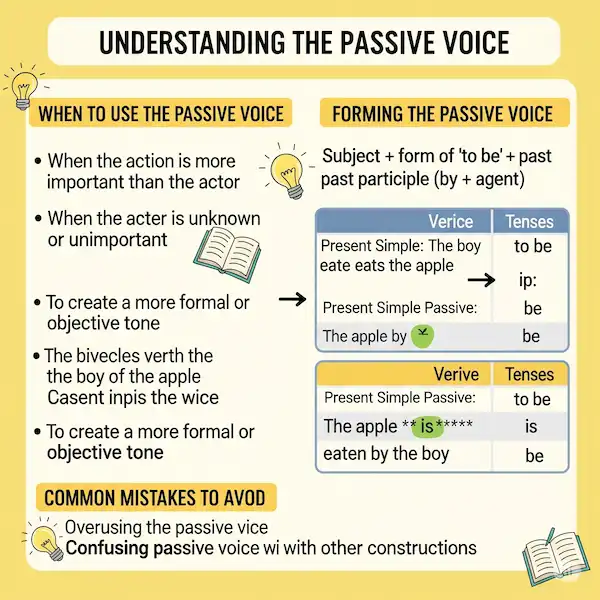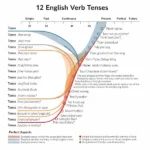Passive Voice: When and How to Use It Correctly
Welcome, intermediate English learners! Understanding the passive voice is a key step in improving your English writing and comprehension. While often advised to use the active voice for clarity and directness, the passive voice has its specific and useful purposes. This article will explain when and how to use it correctly, with plenty of examples and a helpful chart.
What is Passive Voice?
In the active voice, the subject of the sentence performs the action:
- Active: The dog chased the ball. (The dog does the chasing.)
In the passive voice, the subject of the sentence receives the action. The actor (the one performing the action) is either unimportant, unknown, or mentioned at the end of the sentence with the preposition “by”:
- Passive: The ball was chased by the dog. (The ball receives the action of being chased.)
The structure of the passive voice is usually: Subject + be (am/is/are/was/were/been) + past participle of the verb (+ by + actor)
Here’s a quick look at verb tenses in the passive voice:
| Active Voice | Passive Voice | Example |
| Present Simple: They clean the room. | Present Simple: The room is cleaned. | The office is cleaned daily. |
| Past Simple: She wrote a letter. | Past Simple: A letter was written. | The email was sent yesterday. |
| Present Continuous: He is painting the house. | Present Continuous: The house is being painted. | The dinner is being prepared now. |
| Past Continuous: They were building a bridge. | Past Continuous: A bridge was being built. | The road was being repaired last week. |
| Present Perfect: We have finished the project. | Present Perfect: The project has been finished. | The report has been completed. |
| Past Perfect: They had sold the car. | Past Perfect: The car had been sold. | The tickets had been booked in advance. |
| Future Simple: I will send an email. | Future Simple: An email will be sent. | The package will be delivered tomorrow. |
When to Use Passive Voice Correctly
While the active voice is generally preferred for clear and concise writing, the passive voice is appropriate in certain situations:
- When the actor is unknown or unimportant:
- Example: The window was broken. (We don’t know or it’s not important who broke it.)
- Active: Someone broke the window. (Less focus on the action itself.)
- When the focus is on the action or the receiver of the action:
- Example: The new bridge was opened yesterday. (The event is the focus.)
- Active: The mayor opened the new bridge yesterday. (The focus is on the mayor.)
- In formal or scientific writing to maintain objectivity:
- Example: The data were analyzed using statistical software. (Focus on the process, not the person.)
- Active: We analyzed the data using statistical software. (Less formal, more personal.)
- When you want to avoid assigning blame or responsibility:
- Example: Mistakes were made during the process. (Impersonal, avoids pointing fingers.)
- Active: We made mistakes during the process. (More direct and accountable.)
- When the passive voice creates better flow or emphasis in a paragraph:
- Example: The ancient temple stood on a hill overlooking the valley. It was built centuries ago by a forgotten civilization. (Connects the second sentence to the subject of the first.)
Examples in Different Contexts
Everyday Situations:
- Active: My wallet was stolen.
- Passive: My wallet was stolen. (Actor unknown)
Academic Writing:
- Active: Researchers conducted the experiment.
- Passive: The experiment was conducted by researchers. (Focus on the experiment)
News Reports:
- Active: A fire destroyed several buildings.
- Passive: Several buildings were destroyed in a fire. (Focus on what happened)
Common Mistakes to Avoid
- Overuse of passive voice: This can make your writing sound weak, vague, and difficult to follow. Aim for a balance between active and passive voice.
- Unnecessary use of “by + actor”: Only include the actor if it adds important information.
- Weak Passive: The report was written by a committee.
- Better Active: A committee wrote the report.
- Appropriate Passive: The report was written based on extensive research. (Actor unimportant)
EAAT Helpful Content
For English as a Second Language (ESL) learners, understanding the passive voice can be challenging due to its grammatical structure and different word order compared to many other languages. Here are some additional tips:
- Practice identifying active and passive sentences: Read various texts and try to identify which sentences are in the active and passive voice. Pay attention to the verb structure.
- Rewrite passive sentences into active sentences (when appropriate): This exercise will help you understand the relationship between the subject, verb, and object.
- Focus on the “be” verb and the past participle: Recognizing these two components is key to identifying the passive voice.
- Pay attention to context: Consider why the writer might have chosen to use the passive voice in a particular sentence. What is the focus? Is the actor known?
Additional Helpful Content
- Think about the “why”: Before using the passive voice, ask yourself why you are choosing it over the active voice. If you can’t identify a clear reason, the active voice is likely the better choice.
- Read widely: Pay attention to how native English speakers use both active and passive voice in different types of writing.
- Get feedback on your writing: Ask a teacher or language partner to review your writing and point out any instances where you might have misused the passive voice.
Conclusion
The passive voice is a valuable tool in English, but it should be used intentionally and correctly. By understanding when it is appropriate and how to form it accurately, you can enhance your writing and communication skills. Remember to aim for clarity and conciseness, and use the active voice whenever possible, reserving the passive voice for specific situations where it serves a clear purpose. Keep practicing, and you’ll master this important aspect of English grammar!
Practice Makes Perfect
Here is a PDF worksheet you can download with 25 practice sentences about using Passive Voice. The answers are on a separate page.
Additional Helpful Content
- Study about Gerunds and Infinitives – Gerunds vs Infinitives – A Guide for English Learners
- Learn the differences between British and American English – British vs American English: More Than an Accent
External Links for Further Learning
- British Council – Learn English: https://learnenglish.britishcouncil.org/english-grammar/active-or-passive
- Grammarly Blog: https://www.grammarly.com/blog/active-vs-passive-voice/
- Purdue OWL (Online Writing Lab): https://owl.purdue.edu/owl/general_writing/academic_writing/active_and_passive_voice/index.html




